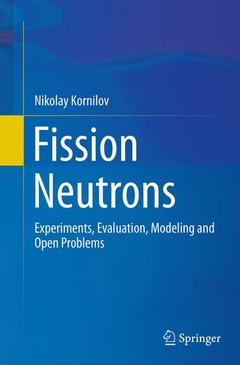Fission Neutrons, Softcover reprint of the original 1st ed. 2015 Experiments, Evaluation, Modeling and Open Problems
Auteur : Kornilov Nikolay

Although the fission of heavy nuclei was discovered over 75 years ago, many problems and questions still remain to be addressed and answered. The reader will be presented with an old, but persistent problem of this field: The contradiction between Prompt Fission Neutron (PFN) spectra measured with differential (microscopic) experiments and integral (macroscopic and benchmark) experiments (the Micro-Macro problem). The difference in average energy is rather small ~3% but it is stable and we cannot explain the difference due to experimental uncertainties. Can we measure the PFN spectrum with high accuracy? How may we compare results of different experiments to provide better accuracy? Are our traditional theoretical models correct? What can be done to solve the Micro-Macro problem in future? These questions are discussed in this monograph for the reader. The current work will be of interest to graduate students and researchers, particularly those working in nuclear and neutron physics.
Introduction.- Experiments.- 2. Microscopic experiments.- Method based on fission event counting.- Neutron spectroscopy by Time of Flight Method (TOF).- Time correlated background.- Time shift in neutron detector.- Neutron-gamma discrimination and its influence on results.- Measurement of the neutron detector efficiency.- Time resolution and “bin” corrections.- Additional time spread for “solid sample” experiment at low input energy.- Possible distortion factors in 2nd type experiment.- The calculation of the detector efficiency with high accuracy up to 20MeV.- Correction for neutron scattering in FF detector.- Multi detectors systems and “cross talk correction”.- Macroscopic experiments.- 3. Microscopic spectra evaluation. Semi-empirical modeling.- Maxwellian function and Terrell’s systematic.- 252Cf spectrum evaluation.- Two Watt Spectra (TWS) approach.- Maxwellian together with power expansion for 235U(th).- Scale Method.- PFNS for multiple chance fission.- 4. Models for neutron emission in fission.- Basis for theoretical modeling.- True or plausible results?.- Model realized in code FINE (FIssion Neutron Emission).- Estimation of the two-dimensional Y(A,TKE) distribution.- Neutron emission from excited fragments.- Monte Carlo simulation of energy-angular distribution. Verification.- Level Density verification.- Comparison experimental and calculated results.- 5. Achievements and still open problems.- Real achievements.- Mechanism of neutron emission in fission.- Left-right and angular effects for fission neutron emission at 0.5 MeV input energy.- Contradiction between Microscopic and Macroscopic experiments (Mic-Mac problem).- New experimental proposal.
Date de parution : 09-2016
Ouvrage de 132 p.
15.5x23.5 cm
Date de parution : 08-2014
Ouvrage de 132 p.
15.5x23.5 cm



